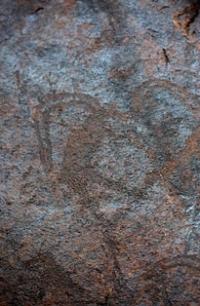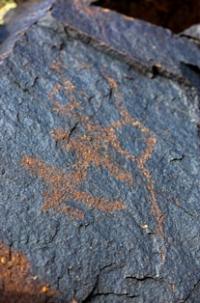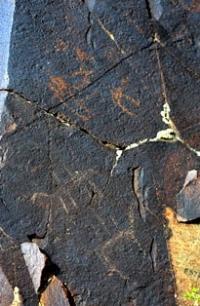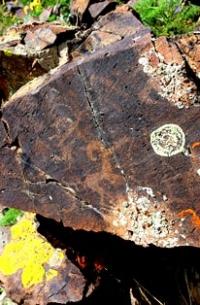Вы здесь
Rock art site of Akterek.





Petroglyphs Visitor Guide Kazakhstan.
“If you follow the ancient maps written on the stars, no person will ever understand you. So if you could read these maps, would you follow them? And forever be misunderstood? Or would you close your eyes tightly and pretend to be like everyone else?”
C. JoyBell C.
Archeology & Petroglyphs Kazakhstan.
Situation and research history the rock art site of Akterek.
In 2012, a rock art site situated 110km west- of Almaty and 5km south of the village of Akterek was signaled by Alexei E. Rogozhinsky from the Scientific Directorate of Tamgaly Museum, who carried out a systematic prospection in 2013 and 2015.
The site is situated on six hills in a narrow valley orientated east-west and is on the left bank of a mountain stream. The petroglyphs are spread over a length of 1,500m and a width of 400m at between 1,130 and 1,260m altitude.
The hillsides are south-facing and the engraved stones are mainly at the summit, even if several other drawings are also situated on the slope and at the foot of the hills. This valley, on the northern foothills of the Zhetyzhol mountain chain on the Kirghizstan border, is near several other important rock art sites: Tamgaly - UNESCO World Heritage- is 65km north (Rogozhinsky 2011; Hermann et al. 2014a); Degeres is 25km north-east (Hermann et al. 2014b); Akkainar is 45km north-nodhest (Hermann 2015) and Kulzhabasy is situated 70km north-west (Hermann & Zheleznyakov 2012).
There are visible traces of a probable Turco-Medieval occupation at the western extremity of the site, between the foot of a hill and a water-course. There are numerous Iron Age kurgans and several Bronze Age tombs between the steppe plain that opens out to the east of the valley and the present village of Akterek.
Themes and dating the rock art site of Akterek.
In total, 1,462 petroglyphs on 219 stones have been documented. 354 petroglyphs on 84 stones date to the Bronze Age; 1,019 pecked-out drawings on 157 rocks have been attributed to the Iron Age; 80 engravings on 27 panels go back to the Turco-Medieval era and 8 drawings on three rocks were done between the XVIII and the beginning of the XXth centuries.
53 rocks contain drawings from fwo, even three, different epochs, essenf/a//y the Bronze and Iron Ages together (43 cases). Regarding the whole of the drawings, 1,274 animals, 202 anthropomorphs and 17 signs have been inventoried.
Note that representations of riders on a horse or camel have been counted as a single drawing while being both in the animal and anthropomorphic categories. For the Bronze Age, 272 petroglyphs represent animals: 94 caprines, 73 canids, 57 bulls, 14 horses, 9 camels, 7 cerzids, as well as 2 bears and a wild boar. 15 animal figures cannot be identified.
Among the 80 anthropomorphs, there is a panel with two humans firing arrows at each other (Fig. 3A), another with 5 bow and axe-armed anthropomorphs clashing (Fig. 3B), as well as a third panel showing an archer affronting a bow-armed horseman (Fig. 3C).
Additionally, there are 4 sun-men (Figs. 4A-D, & 6), 3 riders, as well as a man seemingly dancing on the back of a horse (Fig. 7A). Also, we count 33 hunters, one chasing a caprine with a club, 17 hunting caprines, 7 confronting bulls and seemingly protecting their flock of caprines from attack by wolves.
Only one anthropo- morph falls into the category of worshipper, with arms raised to the sky, while 28 others have no activity. Among these, 8 are in the company of bulls, 3 of caprines, one with a horse and one more with a camel.
We can therefore interpret these latter as being linked to pastoral activities. A large panel also shows 8 anthropoporphs in the company of 10 caprines, a horse, 7 wolves and a stag, without however giving any sense of a reading.
The sun-men are on isolated panels. Contrary to most of the other regional sites, they are small in size, the smallest measuring 9cm and the two biggest only 28cm. Two of these join the moonman type, like those known at Karakyr (Potapov 2007: 38) and in the Akkainar (Hermann 2015: 7), while the two others are more similar to certain types at Tamgaly with a concentric head (Rogozhinsky 2009: 54).
Among particular representations of which we know no other examples, noteworthy is a man seemingly trying to master two bulls, unless this is a scene of worship, as well as 3 anthropomorphs on the back of a stag. 6 signs, including 3 wheels, can also be attributed to the same period.
With 720 caprines (78% of the animals from this period) and 103 wolves, generally attacking flocks of goats. We also see 30 cervids (both sexes), 22 camels and 22 horses ; 23 drawings are impossible to attribute to a specific species.
Among the rarer species, there is a representation of a snake and one of a bear, a wild boar and a fish, as well as 3 eagles, one of which is in the Scythian animal style typical of Siberia, a style rarely found south of Kazakhstan. Among the 93 anthropomorphs, 9 are on horseback and, in one case, on a camel.
There is also a man with arms and legs spread wide. Others are always armed with a bow and hunting deer, wild caprines or wolves. For the Turkish Medieval Period, 68 of the 80 petro- glyphs represent animals, with 39 camels (with a rider in 15 cases), 15 caprines, 6 cervids, 3 horses (all with a rider), 3 canids and 2 bulls.
Among the 27 anthropomorphs, there are 9 bow-armed hunters as well as the 18 camel or horseback riders. The panels show essentially camels alone or in a caravan, as well as hunting scenes, notably of cervids.
The two bull representations seem to have been inspired by neighbouring Bronze Age panels. A clan sign called tamga known from other regional sites also dates to this period (Rogozhinsky 2012: 94). Additionally 6 Iron Age panels were renovated and completed by the addition of several caprines in the Turkish era.
Style and technique of the Bronze Age petroglyphs the rock art site of Akterek.
The majority of the Bronze Age drawings were pecked- out and characterized by the attempt to render the animals as tridimensional by showing them with their four legs. Their body is made up of large pecked-out solid fills, as with those of the humans, if the animals are drawn in profile, the anthropomorphs are either face-on or in profile.
The dimensions of these petroglyphs are generally modest, no bigger than some twenty centimeters, even if several rare drawings can be bigger, notably a representation of a bear nearly 50cm long. Several panels from this period however distinguish themselves by their style and technique.
The animals and humans have dimensions of just a few centimeters, with a very limited pecking-out. In certain cases, the details were executed by a fine line engraving and not by pecking-out, in particular for the bowstrings.
Movement dominates these scenes and the animals sometimes only have two legs. Two war scenes in particular were done in this style. This very specific technique and style are found on no other site in the Akterek region.
The two other places where there are similar figures, notably for several battle scenes, are in Kazakhstan at Eshkioimes (Baipakov et al. 2005), 350km north-east of the site, as well as in Kirghizstan at Tchon Tchatchikei (unpublished), 250km south-west of Akterek.
Note also that war scenes are absent from other regional sites, except for two in the Akkainar (Hermann 2015: 8 - 9).
Conclusion about the rock art site of Akterek.
Akterek completes the spectrum of Southern Kazakhstan rock art sites with a large variety of drawings from three different eras, with several rare themes and representations. The Bronze Age is given a certain significance by the presence of four sun-men, even if several themes from this period are absent, such as the erotic scene or the chariots.
On the other hand, the three battle scenes, in a style unique for the region, suggest that the site saw the passage of a population of a different culture. Given the large number of camelids in each era (71 in total), it would seem that this valley served as a passage between the Kazakhstan steppes and the fertile region of Tchoui in Kirghizstan, our site being a stopover before the mountain crossing.
With the complexity of the valley and its numerous abrupt slopes, it cannot be excluded that new discoveries will come to enrich the existing inventory.
Authority:
Luc Hermann & Boris Zheleznyakov.
Les Closures, 6 B-4970 Stavelot Belgique - lhermann2@hotmail.com 2 State Museum TamgalyTTanbaly, Karasay Batyr, 257, Uzynagash, Kazakhstan.
Photos by
Alexander Petrov.







